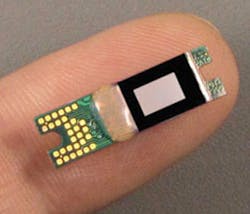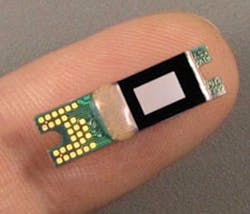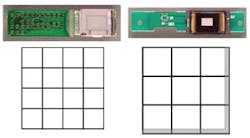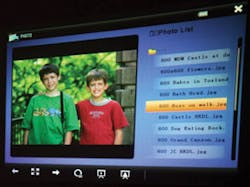PICOPROJECTION DISPLAYS: Laser-LCOS microdisplays make for tiny, low-cost picoprojectors
Lasers combined with liquid-crystal-on-silicon technology enable picoprojectors with very high efficiency (lumens per watt), high brightness and resolution, reduced speckle, and focus-free operation that are affordable and small enough to embed in cell phones and cameras.
KARL M. GUTTAG
The unique optical properties of lasers combined with small-pixel liquid-crystal-on-silicon technology and digital-light-processing microdisplays are enabling small, highly efficient picoprojectors with high resolution and focus-free operation. The laser beam is optically expanded to illuminate the full pixel array of the microdisplay and then the image is optically magnified.
Picoprojectors use lasers in two ways: laser beam steering (LBS) or laser illumination of microdisplay spatial light modulators (see www.laserfocusworld.com/articles/314431). With LBS, either a single bidirectional or two unidirectional mirrors are used to sweep a laser beam that is about one pixel wide. In the case of microdisplays, a two-dimensional array of pixel mirrors modulates the laser light for each pixel.
Small-pixel microdisplays
Liquid crystal on silicon (LCOS) is formed by sandwiching liquid-crystal (LC) material between a cover glass with an optically transparent electrical coating of indium tin oxide (ITO) and a complementary metal-oxide semiconductor (CMOS) integrated circuit. Individual pixels are formed by patterning the top metal layer that acts as both reflective mirror and electrode to control the LC above the mirror/electrode layer. The CMOS substrate supports the integration of transistors under each of the mirrors, as well as memory and processing functions to control each pixel. The "mirrors" that control each pixel in an LCOS device are planar and do not physically move but instead apply a small electric field that causes the LC to change the polarization of light that—with polarizing optics—is used to control the intensity of each pixel (see Fig. 1).
Digital Light Processing (DLP) also starts with a CMOS substrate but then adds a microelectromechanical-systems (MEMS) superstructure to build a physically tilting/moving mirror. Because the LCOS mirrors are planar and do not move, they also do not require the mechanical moving superstructure of a DLP, making it possible to pattern smaller mirrors with smaller spacing between the mirrors. Typical LCOS technology has a spacing gap that is about half that of DLP which enables a much better "fill factor" (ratio of the area of the mirror to the area of mirror plus spacing) for small pixels. A better fill factor results in better light efficiency and eliminates the "screen-door effects" of seeing a grid around each pixel.
FIGURE 1. An 854 × 480-pixel microdisplay is only 6 mm tall on its shortest side. (Courtesy of Syndiant)
A typical small LCOS pixel mirror has a 5.4 µm pitch (from center to center) with 0.29 µm spacing and a 93% fill factor, and is about half the area of the smallest DLP pixels with about a 7.56 µm pitch and 0.29 µm spacing with a 90% fill factor (see Fig. 2). Smaller pixels and smaller gaps between pixels are important for supporting small yet high-resolution microdisplays.
High resolution
Microdisplays with rectilinear pixel grids have an effective resolution advantage over raster-scanned LBS. With fixed pixel grids the resolution will be equal to the pixels in x and y. But for LBS displays, the effective resolution is generally lower due to the nonlinear sweeping, beam alignment, and scaling/resampling to reduce beam sweep distortions.
Decreasing the pixel size allows the resolution to increase while maintaining a small form factor with microdisplays is to. With LCOS there is still considerable scaling that can be done by taking advantage of currently available CMOS processes to enable 720 pixel (720P) and 1080P "HD" resolutions.
Field-sequential color
To meet the size and cost requirements for a picoprojector microdisplay, field-sequential color (FSC) is used wherein a single full-color image is shown as a sequence of color fields. As each color field is imaged by the microdisplay, the corresponding color laser is turned on. DLP is well known for using FSC, which requires a light modulator with a rapid response to provide rich, saturated colors. Field-sequential-color LCOS microdisplays utilize smaller cell gaps between the top glass and mirror, as well as high-speed LC formulas that are 10 to 50 times faster than the LC used in typical direct-view LC displays (LCDs).
Laser light with microdisplays
Perhaps the most misunderstood capability of laser-illuminated microdisplays is that, because of the optical properties of the laser light, they can be focus-free even though they use a projection lens. Even after the laser beam has been expanded and despeckled (if necessary) the resultant light illuminating the microdisplay has a very high f-number (low angular divergence) that does not require focusing. With laser illumination, the image will be well focused from very short distances to infinity (see Fig. 3).
FIGURE 3. A projected image is skewed at an angle to demonstrate that the image is focus free in a laser-microdisplay picoprojector. (Courtesy of Laseno)
Laser light also enables smaller microdisplays because today the active area of microdisplays is made bigger in order to help collect light from light-emitting diodes (LEDs). With laser light, essentially all of the light can be collected regardless of the display size. As a result, very small pixel microdisplays benefit from using laser light.
Lumens-per-watt efficiency
The largest market for picoprojectors is expected to be in battery-powered applications, meaning that efficiency of the display device and the light source are important factors. The high f-number of laser light results in a high percentage of that light being collected and projected so very little light is lost in the optics.
Liquid-crystal-on-silicon devices work by changing the polarization of light and thus require polarized light illumination. Most lasers naturally generate highly polarized light, which improves their efficiency compared to LEDs when used with LCOS microdisplays.
Laser illumination of microdisplays can also use slower-switching continuous-wave (CW) lasers that are generally more energy efficient, more widely available, and lower in cost (particularly for green) than the high-speed switching lasers required for LBS.
Over 20 lumens/W has already been achieved with a laser LCOS projector that has 100 lumens with 5 W of power.1 With the expected improvement in lasers, LCOS devices, and optics, over 30 lumens/W is expected in the very near future with laser microdisplay systems.
Despeckle
After cost considerations, the second biggest issue for using lasers in picoprojectors is the speckle caused by narrow-spectrum coherent light. There are two commonly used approaches to reducing speckle: spectral broadening and varying the effective distance. Often designs will incorporate multiple despeckling techniques.
A well-known technique for despeckling direct-diode lasers is to add some high-frequency modulation into the drive circuit of the laser that will cause it to output a broader range of wavelengths. This technique helps for the red and blue devices that are readily available, as well as the direct green lasers being developed today (see www.laserfocusworld.com/articles/369696). The spectrum-broadening technique generally does not work well for frequency-doubled lasers because the doubling crystal/cavity is designed to resonate at only one frequency and any change in frequency will cause a significant drop in light output.
The most common approach for breaking up narrow-spectrum laser light is to send the beam through time and/or spatially varying path lengths. These techniques use either rotating or vibrating optical elements or an electronically modulated element.
Microdisplay-based laser system
For a microdisplay-based laser projector with a pure FSC system, the lasers will be sequentially turned on; however, it is also possible to have two or all three of the lasers on at the same time for some mixed color fields (see Fig. 4).
FIGURE 4. In a typical laser-microdisplay picoprojector, red, green, and blue lasers are fed to the LCOS microdisplay and projected. (Courtesy of Syndiant)
Dichroic filters are used to combine the red, green, and blue light. There is some form of despeckle and beam-shaping optics in the setup, although this varies in each design. Next, the laser beam enters the optical path where the beam is expanded and converted from a typical Gaussian profile into a more flat profile for illuminating the microdisplay.
In the case of LCOS, a beamsplitter directs the polarized light from the lasers to the microdisplay. A polarizing beamsplitter will reflect one polarization of light and pass the other. Each pixel/mirror/electrode of the LCOS microdisplay controls the LC over that pixel to change the polarization of the light for each pixel that is nonblack so that some or all of it (depending on the intensity) will pass through the beamsplitter after it reflects off a given pixel's mirror. The light out of the beamsplitter then goes to the projection lens that expands the resultant image for viewing.
One of the major benefits of laser light is that the projection lens and the rest of the optics, including the microdisplay, can be made smaller and simpler and yet still have very high efficiency. Laser-microdisplay optical engines can be made as small as 3 to 4 cm3 in volume.
Eye safety
Laser-microdisplay systems have an important advantage over LBS for eye safety, another major concern for lasers. Whereas LBS requires that the laser light remain a single-pixel-size beam, in a laser-microdisplay system the laser beam is first spread out over the area of the panel and then the projection lens further spreads the light. This reduces the light density at any given point and allows laser-microdisplay systems to reach higher projected brightness levels within the limits of international safety standards.
The applications for laser-LCOS picoprojectors are boundless. The most obvious will be in very small and energy-efficient projectors for embedding in cell phones, still and video cameras, and in media players. Less obvious applications include automotive displays and digital signage. Syndiant laser-microdisplay picoprojectors for consumers started shipping in the latter part of 2009 and are expected to go into high-volume production in late 2010.
REFERENCE
- T. Mizushima et al., SID 2009 Digest, p. 268 (2009).
Karl M. Guttag is CTO at Syndiant, 18325 Waterview Parkway, Suite A101, Dallas, TX 75252-8026; e-mail: [email protected]; www.syndiant.com.
Tell us what you think about this article. Send an e-mail to [email protected].
More Laser Focus World Current Issue Articles
More Laser Focus World Archives Issue Articles




